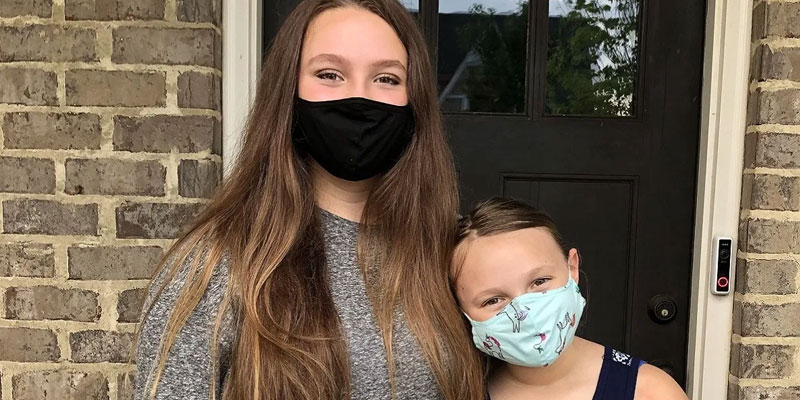Although it’s no picnic, wearing a face mask gets easier.
That’s Elizabeth Perkins’ message to kids who have not yet started back to school. After more than a week of wearing a face mask for about six hours a day at school, the eighth grader at Bessemer Academy advises other students to practice wearing their mask at home as much as possible before returning to the classroom.
“Wearing a mask was hard at first,” said Perkins. “The first day, I tried to get away from people for a few minutes so I could pull it away from my face just to try to breathe. Now it’s still a little weird, but I think I’m getting used to it.”
Dr. Gigi Youngblood, a pediatrician at Pediatrics East – Children’s of Alabama, agrees that encouraging kids to practice social distancing and wearing face coverings, and reminding them to thoroughly wash their hands are the keys to keeping them safe. Whether they are in the classroom or taking part in remote learning at home, children need to understand the importance of practicing these safety measures, she said.
But how do you get kids on board?
“First and foremost, we have to model good behavior for our kids,” said Youngblood. “Kids never respond to ‘Do what I say, not what I do.’ Then, we have to help kids understand that they are protecting their family, friends and neighbors as much as themselves.”
Youngblood said even the youngest child knows what it means to get sick.
“Kids are taught early on that we are susceptible to germs,” she said. “We can help them understand COVID-19 by explaining that there’s a new germ, and we don’t know how susceptible our bodies are to it. We don’t want them to be terrified of getting sick. So we take the focus off them and encourage them to focus on doing these things to protect others to keep them from becoming overwhelmed during these scary times.”
Youngblood said children and teenagers alike are susceptible to the virus.
“From the data we have available now, we think young kids are less likely to become severely ill, but they can spread the virus to the adults who care for them. That’s why masking and social distancing are so important,” she said.
Youngblood said wearing a mask is one of the most straightforward, effective strategies for keeping children safe. Other ways to prevent the spread of viruses like COVID-19 include physical distancing, good hand hygiene, health screenings and rapid response to any symptoms. Using these tools can greatly reduce the spread among kids.
Youngblood said universal masking is one of the best ways to prevent large-scale school quarantines or closures. But learning to adapt to a mask takes time.
She offers tips to help students become comfortable with their masks before entering a classroom. These tips will also help kids who are learning at home because they will need to wear a mask when accompanying parents outside the home.
- Allow children to pick their mask. There are many styles and designs. The key is to choose a two- or three-layer mask that covers the nose and mouth, and stays in place during normal movement. Avoid masks with an exhalation valve because they allow droplets to pass from the wearer to other people.
- After washing the mask, encourage your child to wear it for a few minutes in a stress-free environment. With young children, parents can often convince them by donning their own mask. Then, use positive reinforcement and praise to reward children for meeting their goal.
- Begin slowly increasing the amount of time that your children are wearing a mask. Don’t be concerned if they are constantly touching or adjusting the mask at first. That’s normal. They will adjust to wearing a mask over time.
- Have children wear a mask while performing indoor activities, like watching TV or playing games on a tablet. Next, take it up a notch by asking them to read aloud, talk on the phone, jump up and down or dance while wearing a mask.
- Have children practice wearing a mask outside in case they are required to wear it on a playground or while taking part in sports.
Youngblood said these tips can be adjusted, depending on a child’s age. She said the only children who should not wear a face covering are those younger than 2 years old or with special needs who can’t remove it without assistance.
Youngblood said adults and kids have to do their part to beat this pandemic. She added that even for a health professional, becoming accustomed to wearing personal protective equipment (PPE) all day is not easy.
“When I first started wearing a face mask and face shield in March, it felt very cumbersome,” said Youngblood. “Now, if I go into a patient’s room, and I forget to put it on, it doesn’t feel natural. Now wearing PPE is second nature.”
Youngblood said giving other people “grace and support” is crucial.
“Remind your kids that they are doing an important job by helping to keep others in their community safe and healthy,” she said. “We need to help protect each other so we will have a healthy, thriving community when this pandemic is over.”
Parents should consult their child’s pediatrician to answer questions or get more information.
(Courtesy of Alabama NewsCenter)
Don’t miss out! Subscribe today to have Alabama’s leading headlines delivered to your inbox.
